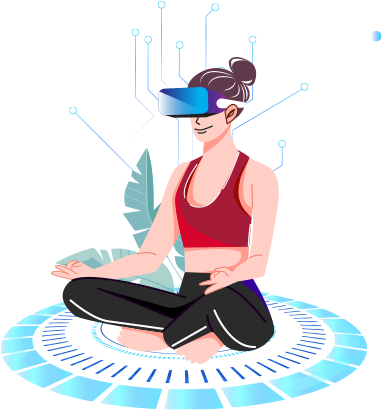Therapeutic Virtual Reality
Technology applied to chronic pain management, backed by science and proven results.
The information provided on this page is for informational purposes only and does not replace consultation with a qualified healthcare professional. Virtual reality therapies should be conducted under the supervision of trained professionals.
What is therapeutic virtual reality?
Therapeutic Virtual Reality (VR) for chronic pain uses immersive technology to help retrain the brain’s response to pain. Through structured sessions with VR headsets and pain education meetings, patients are exposed to interactive experiences that blend neuroscience, mindfulness, and cognitive techniques.
This innovative approach helps reprogram how the brain perceives and responds to pain, promoting relief, emotional regulation, and better adherence to treatment.

How it works
Therapeutic VR uses visual and auditory stimuli to activate brain areas associated with pain perception in a controlled, immersive environment. During the sessions, patients engage in scenarios designed to reduce the central nervous system’s sensitivity to pain while learning, in a guided and practical way, to interpret their body’s signals more effectively.
This process of brain retraining is made possible through neuroplasticity — the brain’s ability to reorganize itself and form new connections, even in cases of chronic pain.
Therapeutic applications
Virtual reality has shown promising results in the treatment of:
- Chronic lower back pain
- Fibromyalgia
- Arthritis and other inflammatory diseases
- Persistent musculoskeletal pain
- Functional rehabilitation with residual pain
- Anxiety and depression related to chronic pain

Benefits of therapeutic virtual reality
- A safe alternative with no side effects, reducing reliance on medication
- Validated protocol that’s easy to implement and well-accepted by patients
- Higher treatment adherence thanks to its interactive and engaging format
- Significant reduction in perceived pain
- Overall improvement in quality of life, both physically and emotionally
Scientific evidence
Numerous studies support the effectiveness of therapeutic VR in managing chronic pain:
- Hippert (2021) demonstrated significant pain reduction and increased treatment adherence in patients with rheumatoid arthritis.
- De Vries et al. (2023) reported better emotional regulation and understanding of pain among patients with chronic lower back pain.
- Slatman et al. (2024) found improved quality of life in patients using multimodal VR protocols.
FAQ
Yes. Clinical studies show that therapeutic VR can reduce pain perception by retraining the brain’s pain-processing pathways. Through immersive and guided experiences, patients learn how to modulate pain more effectively.
Not necessarily. VR therapy can serve as an alternative or complement to traditional treatments, depending on the individual case. Its key advantage is the absence of side effects and the potential to reduce long-term use of painkillers.
Yes. Therapeutic VR is safe and well-tolerated, with minimal risk of adverse effects. It’s important that the therapy follows a validated protocol and be supervised by trained professionals.
Sessions are conducted using VR headsets and can take place at home or in a clinical setting, depending on the protocol. They combine mindfulness, biofeedback, simulations, and pain education — offering an interactive and therapeutic experience.


Innovative healthcare solutions for unconventional treatments, focusing on medicinal cannabis, psychedelic therapies and advanced technologies.
Quick Links
Get in touch
- +1 786-480-2830
- commercial@37miles.us
- @thirtysevenmiles
- 37 Miles
© 2025 – 37 Miles. All rights reserved.
